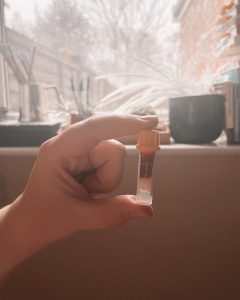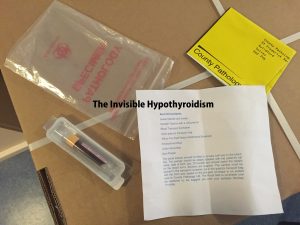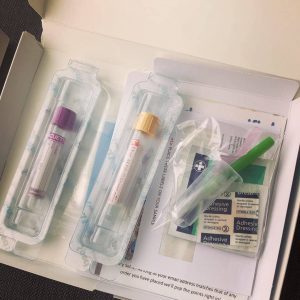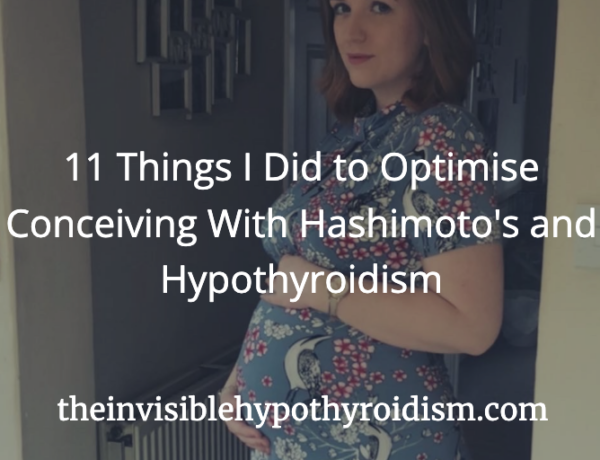Originally published on 29th May 2016 Last updated on 5th August 2024
It’s a term I, and so many other sources for thyroid information, use a lot.
But what Are “Optimal Thyroid Levels”?
When your doctor runs a test and you receive the results, your levels will either fall inside or outside of the range. Ranges are usually given in brackets besides the test result.
However, as thyroid patients, it is important that we advocate for ourselves when it comes to where in range they fall. After all, it is not just about falling within the range. We are looking for something more specific. I cover all of this and so much more about thyroid tests, understanding results and medication options further in my book “Be Your Own Thyroid Advocate“.
‘Optimal levels’ are a more specific section within the given range.
Why Optimal Matters
You’ll find that many thyroid advocacies and progressive medical practitioners agree that when testing a thyroid panel (or “Thyroid Function Test”), a:
- TSH less than 2.5 (and not below the bottom of the reference range)
- Free T3 around the top quarter of the given range
- Free T4 around mid-range
- Antibodies as low as possible / within the normal range
are considered ‘optimised’.
These optimal areas within the given range are where a lot of thyroid patients say they feel most well. It is more specific than just falling within the very wide reference range.
For example, optimal levels could be: a TSH of 1.5, a Free T3 of 17.5 on a range of 10-20 and Free T4 at 15 on a range of 10-20. (please note: this is just an example – you must go by the lab ranges specific to you and included with your test results!!)
For you personally, you may feel best somewhere else within range, but you should try to find out and maintain levels at what you feel best at. This is the definition of optimising your thyroid treatment.
Since a lot of us didn’t have our thyroid levels tested before we developed a thyroid condition and began to feel unwell, we often don’t know what our levels were when we felt well. So you must work with your doctor to find where your own individual optimal levels are.
A study titled The definition of Optimal Metabolism and its association with large reductions in chronic diseases also said:
“Very simply, cells require an optimal amount of T3, the main thyroid hormone for ideal performance… Optimal Metabolism is measurable and specifically defined by the FT3 (free T3) in the upper 20% of the normal range, the TT3/RT3 ratio (total T3/reverse T3) between 10-15… Being in the Optimal Range predictably coincides with substantial reductions in chronic diseases including Subclinical Hypothyroidism and other low T3 states. Being in the Optimal Range results in improved health spans and increased productivity. Substantial reductions in cost of health care also result because repetitive expensive hospitalizations, ER visits, ineffectual repetitive medical workups, and ineffective treatments are eliminated. Optimal Metabolism can improve public health at much lower cost.”
As of March 2022, NICE Guidelines also state:
- If symptoms persist, consider adjusting the dose of LT4 further to achieve optimal wellbeing, taking care to avoid over-treatment.
- If symptoms of hypothyroidism persist, consider adjusting the dose of LT4 further to achieve optimal wellbeing, taking care to avoid over-treatment. This is based on the fact that some people may still have troublesome symptoms even with TSH levels in the reference range, and changes in LT4 dose may improve symptoms for some people.
TSH Suppression
Interestingly, a 2018 study said that:
“Hypothyroid symptom relief was associated with both a T4 dose giving TSH-suppression below the lower reference limit and FT3 elevated further into the upper half of its reference range.” [3]
- For thyroid patients on T3 containing thyroid medication, such as T3 synthetic Liothyronine or natural desiccated thyroid medications, it is worth noting that the higher amount of T3 in these (compared to the ratio of T4 to T3 in a human thyroid gland) may have a suppressive effect on TSH. Therefore, your TSH may be suppressed (below the bottom of the range), yet your Free T3 and Free T4 remain within range and not close to overmedication or hyperthyroidism. [4]
- This is what I personally experience – when my Free T3 and Free T4 sit within range (and no where near the top of the range), my TSH remains suppressed. In the past, even when my Free T3 and T4 have fell below the bottom of their ranges, my TSH still remains suppressed. Multiple thyroid patient advocacy groups, such as Paul Robinson, TPAUK and Stop The Thyroid Madness (to name only a few) report that this happens to a large amount of those on T3 thyroid medications. [5]
- Thyroid patients who have had a thyroidectomy may notice that in order to raise their Free T3 and T4 to optimal, their TSH needs to be suppressed too. [6]
- And for those who have had thyroid cancer, doctors may suppress TSH with thyroid medication, to reduce the chances of cancer recurring, deciding that the benefits outweigh the perceived risks.
What Are Some References That I Can Use When Speaking to My Doctor About Wanting to Reach Optimised Thyroid Levels?
References for TSH:
- In 2002, the National Academy of Clinical Biochemistry (NACB) issued new guidelines for the diagnosis and monitoring of thyroid disease, which reported that the TSH reference range was too wide and actually included people with thyroid disease, thus making it inaccurate.
- When more sensitive screening was done, which excluded people with thyroid disease, 95% of the population tested had a TSH level between 0.4 and 2.5. As a result, the NACB recommended reducing the reference range to those levels. [1]
Based on the NACB’s findings, in January 2003, so just a few months later, the AACE (American Association of Clinical Endocrinologists) made this announcement:
“Until November 2002, doctors had relied on a normal TSH level ranging from 0.5 to 5 to diagnose and treat patients with a thyroid disorder who tested outside the boundaries of that range. Now AACE encourages doctors to consider treatment for patients who test outside the boundaries of a narrower margin based on a target TSH level of 0.3 to 3. AACE believes the new range will result in proper diagnosis for millions of Americans who suffer from a mild thyroid disorder, but have gone untreated until now.”
Furthermore, the third National Health and Nutrition Examination Survey (NHANES III) screened 17,353 subjects from 1988 to 1994 and excluded those with diseases or factors known to affect thyroid function too. In the resultant ‘normal’ population of 13,344 subjects, 95% had TSH levels that fell between 0.3 and 2.5, which is almost identical to the findings of the NACB above, again, backing up a TSH below 2.5. [2]
References for Free T3:
Regarding aiming to have a Free T3 higher in range, a 2018 study reported that:
“Hypothyroid symptom relief was associated with both a T4 dose giving TSH-suppression below the lower reference limit and FT3 elevated further into the upper half of its reference range.” [7]
and
“Hypothyroid symptom relief was associated with… FT3 elevated further into the upper half of its reference range… Residual hypothyroid complaints in LT4-treated patients are specifically related to low FT3 concentrations. This supports an important role of FT3 for clinical decision making on dose adequacy, particularly in symptomatic athyreotic patients.” [7]
A study titled The definition of Optimal Metabolism and its association with large reductions in chronic diseases also said:
“Very simply, cells require an optimal amount of T3, the main thyroid hormone for ideal performance… Optimal Metabolism is measurable and specifically defined by the FT3 (free T3) in the upper 20% of the normal range… Being in the Optimal Range predictably coincides with substantial reductions in chronic diseases including Subclinical Hypothyroidism and other low T3 states.”
Moving Forward
- It is important to understand that different labs/doctors use different ranges, so you must interpret your results individually; don’t compare them to anyone else’s. You must use your lab’s reference ranges.
- A Free T4 at 14, with a range of 9-19, is mid-range for example, but a Free T4 at 11 is mid-range for a range of 7.5-14.5. So both are considered optimal readings.
- You must look at your result in comparison to the given range, usually stated in brackets, beside it. Where does it fall?
Work With Your Doctor
I always encourage thyroid patients to get a copy of their test results, for ease of reference and comparison as you try things to correct your thyroid levels and reach good health.
Always work with a doctor on evaluating and reevaluating your thyroid hormone levels, keeping in mind your symptoms and overall health as well. We’re all individuals and there is no ‘one size fits all‘, but there are obviously health risks if your thyroid hormone levels are both too low or too high for an extended period of time.
You can present the above information to your doctor.
It’s important to remember that as we’re all individual, optimal levels can look different for different people too.
Your doctor should be open to adjusting your dose to move you within the reference range – this really isn’t a unreasonable request, but some persuading, listing your ongoing symptoms, will be needed. So go in prepared!
Have you found your ‘optimal thyroid levels’?

References:
[1] http://www.aacc.org/sitecollectiondocuments/nacb/lmpg/thyroid/thyroid-fullversion.pdf
[2] https://www.ncbi.nlm.nih.gov/pubmed/11836274
[3] https://www.thieme-connect.de/products/ejournals/abstract/10.1055/s-0043-125064
[4] https://www.ncbi.nlm.nih.gov/pubmed/15705921/
[5] https://stopthethyroidmadness.com/tsh-why-its-useless/
[6] https://www.sciencedirect.com/science/article/pii/S2214623719301528
[7] https://www.ncbi.nlm.nih.gov/pubmed/29396968
Further reading:
OUR HOLY MIRACLE OF THE INFALLIBLE TSH TEST!









